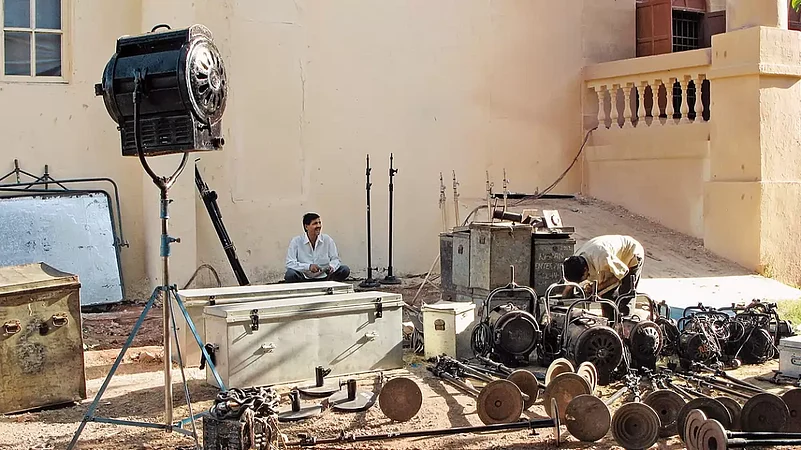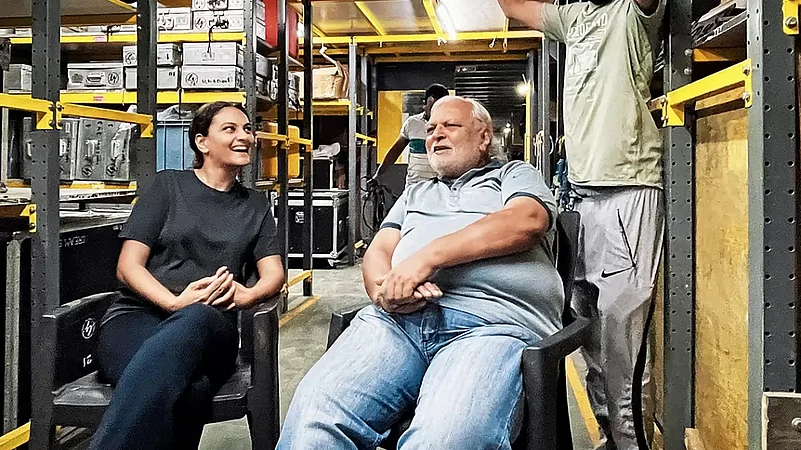In a warehouse in Kandivali in Mumbai, there are rows upon rows of packed light equipment. It is Mulchand Dedhia’s empire that perhaps will not have an inheritor, even though his youngest daughter, Hetal, is the first female gaffer in the industry. Hetal, 37, wants to get into production and direction, to chase her own Bollywood dreams.
Mulchand, 68, started out as a lighting man for weddings and functions and used to install generators in 1967. He grew up in Charni Road in Mumbai and his father was a grain merchant. For a long time, his family didn’t understand what he was doing.
It was in 1978 that he saw a British gaffer working on lighting a set and decided to become a gaffer.
“Those wedding days were a lot of fun. I was even doubling as a DJ and playing these records. I used to get six paisa a day. It was a good life,” Mulchand recalls. “I was surrounded by many young boys and girls who kept asking me to play this or that song.”
It was in 1980 that he first began working as a light man.
“I quit Hindi cinema from 1982 to 1996 and then worked on a few indie films,” he says.
In 1996, he worked on Dev Benegal’s film and a few others but it was all within the circles.

It was a hard life. His son fell and he needed medical care, which was expensive. Back then, he was working on one film in a year and that wasn’t enough. Mulchand hustled to make ends meet.
“I designed bindis and then I joined Lijjat Papad but wherever I was, I was a superpower,” he says.
In 1997, he entered the commercial cinema fray.
“The commercial cinema was not very professional. There were no schedules and things kept changing,” he says. It was Aamir Khan, who he had worked with in 1947 Earth, who called him to work on Lagaan. But Mulchand knew what he was doing. He knew the camera couldn’t see anything without the light and that’s why gaffers were important. He made his own lights. He understood the story has a tonality and that only lighting can provide it. Only the light could create the mood.
The year 2000 became the comeback year for him as a professional gaffer in Bollywood.
Perhaps the struggle, the rags-to-riches story and the legacy of his work has made Mulchand someone who wants to have the last word. After all, he had been involved in Mission: Impossible - Ghost Protocol (2011), Don (2006) and The Bourne Supremacy (2004). Working on so many projects with people from across the world helped him understand a range of techniques.
The warehouse with its trucks and its thousands of lights and staff bear testimony to his craft. Like many others, he had wanted to be an actor and did a few cameos. But, in the end, it was his understanding of light that made him a known name within the industry.
“I had ideas. I never got stuck. Even now I keep playing with lights,” he says.
Today, there are more than 1500 gaffers in the industry. He trained 15 of them in the last 42 years.
“It is not an easy job. Some gaffers are good at designing, a few are good at cabling. Me, I think about the script and design and prepare.”
Hetal, 37, the daughter who broke stereotypes and took on a job that only men did because it involved carrying and operating lights, is the future. She had watched her father work on the sets and then decided to take over the reins. “When she joined, I told her she will never get any help from the boys,” says Mulchand. Hetal started out like any other trainee; she hung around carrying heavy lights in the beginning.
“I thought it was a fun job to become a gaffer and there was always something new,” she says.
Now that she has done it, she wants to try other things. “Your time is gone,” says Mulchand.
“Time never goes,” says Hetal.
When she walks out, her father follows her. There is love and there is the question of legacy. And with light, there are always shadows.
(This appeared in the print edition as "Chiaroscuro")
















